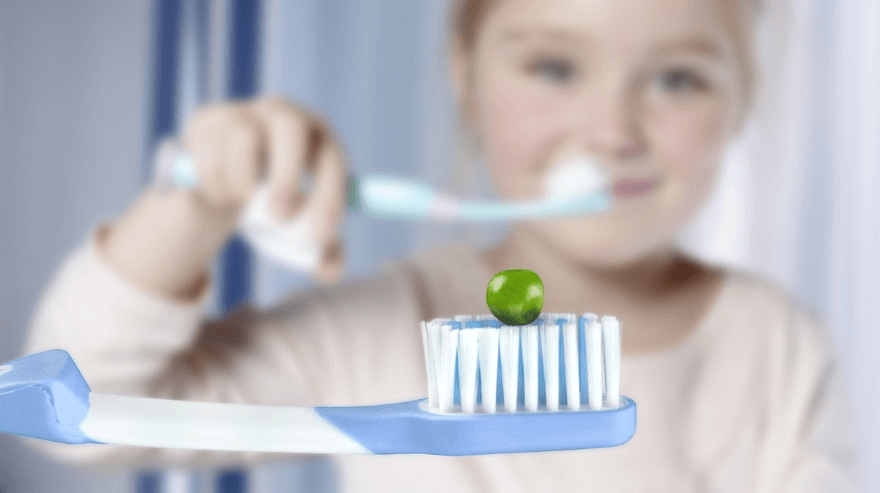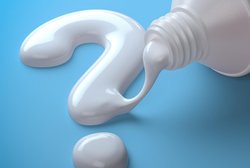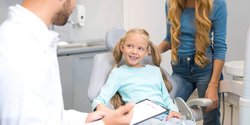Why does Kinder Karex not contain fluoride?
How much toothpaste for children?
Have you ever paid attention to the portioning information on the packaging of your children’s toothpaste? Fluoridated toothpaste for children up to 6 years of age containing 1,000 ppm fluoride or more, may only be used in pea-sized portions on the toothbrush. For children under 2 years old, this recommendation is merely the “size of a grain of rice".
This restriction and the corresponding warning must be listed on these fluoride toothpastes according to the 2009 European Cosmetic Regulation (EC) No. 1223. However, this dosage requirement is being exceeded by approx. 5 times in German bathrooms according to a 2013 study1. The result: An increased risk of fluorosis for children who swallow their toothpaste. Fluorosis is a whitish-yellow discolouration on the teeth that is irreversible.
In many children's oral care products, fluoride is added to protect the teeth from cavities. The addition of fluoride to toothpastes, however, is controversial, especially for children under the age of 6. A fluoride history should always be carried out by the doctor or dentist. Fluoride is not only used for oral care. There are many other sources in everyday life:
- A paediatrician generally prescribes vitamin D pills for healthy bone growth in the first few years of life. These frequently also contain fluoride.
- Along with fluoride pills and toothpastes, fluoridated table salt is another dietary source. In addition, it is also found in many beverages, without this being specially labelled. This makes it difficult for parents to monitor their children’s fluoride intake.
- Since young children swallow much of the toothpaste and do not spit it out, they may unknowingly overdose. In this way alone, you can ingest just as much fluoride as with fluoride pills or table salt.
The German Federal Institute for Risk Assessment points out that too much fluoride can damage teeth and bones in younger years. It therefore explicitly recommends that young children only use one fluoride source: either fluoridated vitamin D tablets, table salt or toothpaste2.
Kinder Karex - with BioHAP - is effective without fluoride and can be used with confidence
Instead, Kinder Karex uses the tooth-related active ingredient BioHAP. This stands for "biomimetic hydroxyapatite" – what our teeth are made of. This active ingredient offers an effective alternative to fluoride and has numerous advantages:
- Young children are frequently not yet able to spit out toothpaste properly, so that they swallow most of it. BioHAP is simply broken down in the stomach and is therefore also harmless when swallowed. Thus, parents no longer need to make sure that the recommended dosage amount for fluoride is adhered to.
- BioHAP forms a protective layer on the tooth surface when teeth are brushed. This makes it harder for bacteria to adhere to the tooth and significantly reduces biofilm (plaque). Plaque, which can form aggressive acids, is the trigger for cavities.
- It has been clinically proven that BioHAP effectively protects against caries. Several studies3,4 conclude that a toothpaste containing BioHAP is just as effective at preventing caries as a toothpaste containing fluoride.
- Daily brushing with BioHAP can even repair small defects in the tooth enamel and support remineralization, i.e. restoring important minerals to the tooth enamel. The hydroxyapatite accumulates on the teeth and tooth necks, and thus also helps with pain-sensitive teeth, e.g. molar incisor hypomineralization (MIH)
Background: Modification to the fluoride recommendations for children's toothpaste
The dosage of fluoride in children's toothpastes is regulated by law. Toothpastes that contain more than 1,000 ppm of fluoride must carry mandatory (legally binding) warnings, e.g. "For adults only".
Since primary-school age children have been frequently developing cavities for many years – nearly every second child in the first grade has had caries at least once – the network "Gesund ins Leben", an association of German professional societies and organisations, has issued recommendations for caries prevention in infancy and early childhood. These recommendations include increasing the fluoride content in children's toothpastes.
As of April 2021, the recommendation is as follows (not legally binding):
- Children aged 0-2 years:
Brushing 2 x daily using a rice grain-sized amount of children's toothpaste with 1,000 ppm of fluoride
Or a toothpaste without fluoride in combination with vitamin D tablets containing fluoride
- Children aged 2-6 years:
Brushing 2 x daily in pea-sized amount of children's toothpaste with 1,000 ppm of fluoride - Children over 6 years of age:
Brushing 2 x daily using children's toothpaste with 1,000 to 1,500 ppm of fluoride
Using a pea-size (0.25 g) or even a rice grain-size (0.125 g) amount of toothpaste seems unrealistic in everyday life. In addition to this, the openings of currently available toothpaste tubes make it difficult or nearly impossible to get this dosage right.
The German Federal Institute for Risk Assessment2 concludes that only one source of fluoride should be used. By swallowing fluoride-containing toothpaste (500 ppm fluoride), you ingest the same amount of fluoride as you would through tablets or fluoridated table salt. When you use a fluoride toothpaste with 1,000 ppm of fluoride, you will be swallowing double that amount of fluoride.
Kinder KAREX in simple terms
modern caries protection | toothpaste for children without fluoride
Dental care for children without fluoride
Sources:
- Creeth, J. et al: How much is a ‘pea-sized amount’? A study of dentifrice dosing by parents in three countries - ScienceDirect. International Dental Journal 2013; 63, 25-30
- Bundesinstitut für Risikobewertung: Für gesunde Zähne: Fluorid-Vorbeugung bei Säuglingen und Kleinkindern; Stellungnahme Nr. 015/2018 des BfR; Fluorid - BfR (bund.de)
- Schlagenhauf, U. et al: Impact of a non‐fluoridated microcrystalline hydroxyapatite dentifrice on enamel caries progression in highly caries‐susceptible orthodontic patients: A randomized, controlled 6‐month trial - Schlagenhauf - 2019 - Journal of Investigative and Clinical Dentistry - Wiley Online Library. J. Invest. Clin. Dent. 10, e12399 (2019)
- Paszynska, E. et al: Impact of a toothpaste with microcrystalline hydroxyapatite on the occurrence of early childhood caries: a 1-year randomized clinical trial | Scientific Reports (nature.com). Scientific Reports volume 11, Article number: 2650 (2021)




 We protect your data!
We protect your data!




